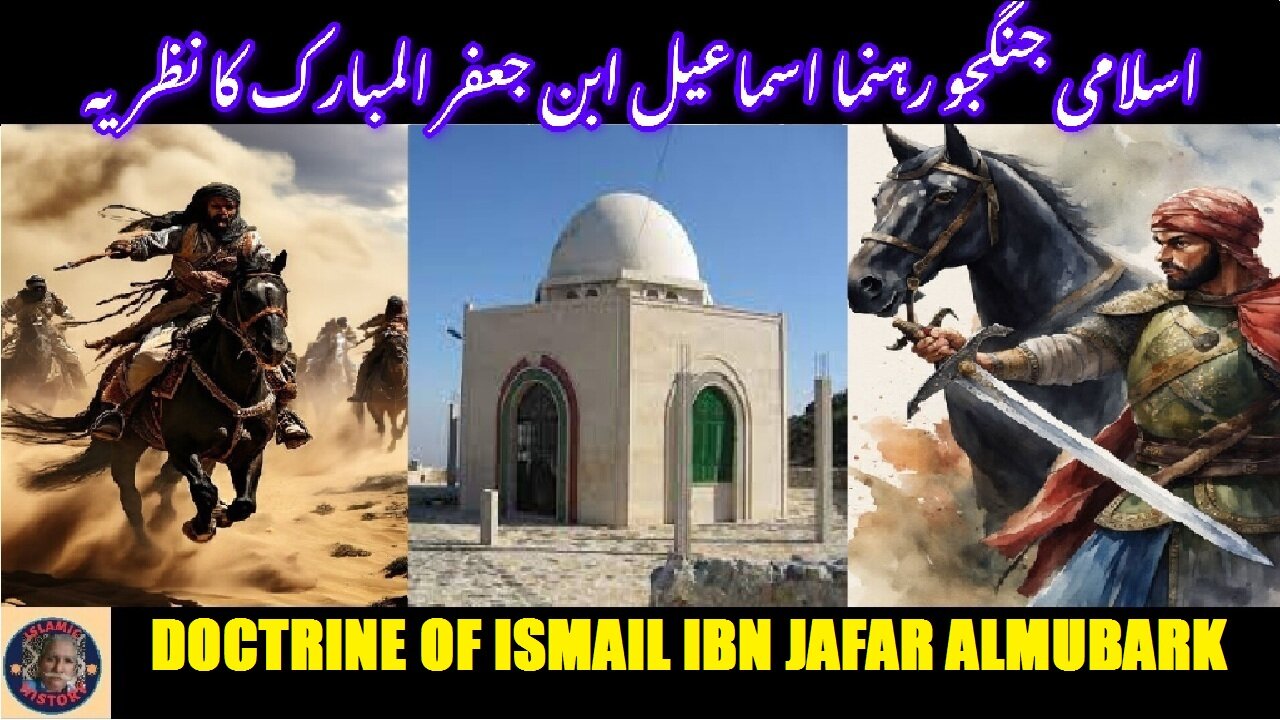Premium Only Content

The doctrine of Ismail ibn Jafar al-Mubarak اسماعیل ابن جعفر المبارک کا نظریہ
@islamichistory813 #IslamicHistory #WarriorLeadership #IsmailIbnJafar
The doctrine of Islamic warrior leader Ismail ibn Jafar al-Mubarak
Dekhti Aankhooon aur sountay kaanoon ko Asslamoalaikum, sisters, brothers friends and elders, This video we are describing the life and teachings of islamic warrior leader Ismail ibn Jafar al-Mubarak, a prominent figure in Islamic history known for his leadership in warfare. We are are describing his doctrine, which emphasizes the principles of justice, courage, and strategic acumen in battle. Through historical accounts and expert analysis, viewers will gain insight into how al-Mubarak's philosophies shaped military tactics and influenced the Islamic world. Please be with us and watch complete video upto end as we are describing the legacy of this remarkable leader.
The Twelver Shia believe that al-Sadiq revoked his first nass in favour of al-Mubarak with radical Shias and made a second nass in favour of his son al-Kazim. This newly contrived theory took its early nourishment among the people who lacked the concept of the Imamate. The Twelver scholar Abdulaziz Abdulhussein Sachedina confirms the problems inherent in the doctrine of bada: "It implied God's change of mind (bada) because of a new consideration, caused by the death of Isma'il. However, such connotations in the doctrine of bada (change of mind) raised serious questions about the nature of God's knowledge, and indirectly, about the ability of the Imams to prophesy future occurrences." Al-Sadiq is also reported to have said: "Inlillah fi kullo shain bida illah Imamah" means, "Verily, God makes changes in everything except in the matter of Imam." This point merits further indication al-Sadiq had no power to cancel, revoke or alter the first nass in favour of al-Mubarak, and therefore, the tradition of change of nass carries no historicity. Al-Nawbakhti writes in Kitab Firaq al-Shia that, "Yet another version is that by appointing his son, Isma'il, as an Imam, al-Sadiq thus resigned. Isma'il was therefore a real Imam, and after him, the Imamate has to pass to his son, Muhammad."Al-Shahrastani writes in Kitab al-Milal wa al-Nihal that, "Designation (nass), however, cannot be withdrawn, and has the advantage that the Imamate remains in the descendants of the person designated, to the exclusion of others. Therefore, the Imam after Isma'il is Muhammad ibn Isma'il."
Succession
The Mubarakiyya claimed that, when al-Mubarak was alive, he appointed his son Muhammad as his heir and sent his da'is to different regions to administer the oath in his name. Another proto-Isma'ili group which is recorded by the sources deemed that al-Sadiq, not al-Mubarak, designated Muhammad ibn Isma'il as the seventh Imam, and he was the last Imam and the Mahdi who remained alive and would return as the Qa'im. This group is said to have formed the nucleus of the Qaramita sect which regarded Muhammad as their seventh and last Imam. Ja'far ibn Mansur al-Yaman writes in Asrar al-Nutaqa that, "Both we and you admit the tradition that when Isma'il was about to die, he summoned his son and his followers, and handed over the Imamate to him, in their presence, under the supervision of his father [al-Sadiq]. He entrusted the testimony concerning the position of his son to one of his hujjats [i.e. da'is], as did his forefather Ishmael (Ismail) with regard to the person surnamed al-Kabsh [lit.sheep] ,appointed before him. He made him the "veil" for his heir, to distract towards him the attention of the tyrants of the time. And al-Sadiq presided over the assembly, as Jacob (Ya'qub) presided over the assembly of Joseph (Yusuf) when the latter was on his deathbed."
The Mubarakiyya held that the right of the Imamate must pass from al-Mubarak, the father, to Muhammad, the son, because the Imamate could not be transferred from brother to brother after the case of Imams al-Hasan and al-Husayn, the sons of 'Ali ibn Abi Talib: it can only go to [the Imam's] progeny. This was why they rejected the claims of al-Kazim and other brothers of al-Mubarak, as they did that of Muhammad ibn al-Hanafiyya, who, according to them, had falsely claimed the Imamate in rivalry with Ali ibn al-Husayn Zayn al-Abidin. At any rate, it is clear that the Mubarakiyya had come into existence in Isma'il's lifetime and they were originally his supporters.[ It may safely be assumed that Mubarakiyya was one of the original name of the nascent Isma'ilism, as well as the regional identifications of the followers of al-Mubarak, who, on the whole, merged into the main fold of Isma'ilism in the time of Muhammad ibn Isma'il.
Al-Nawbakhti, who is best informed about this period, says that the group which supported Muhammad was called the Mubarakiyya after al-Mubarak who was a client, or mawla, of Isma'il. Ivanov has shown that al-Mubarak was the epithet of Isma'il himself, on the basis of some passages from the famous Isma'ili da'i of the 4th/10th century, Abu Ya'qub al-Sijistani, as well as other sources.
so sisters brothers friends and elders, tomorow we are going to described Death of Islamic warrior leader Ismail ibn Jafar al-Mubarak. Allah hafiz
==========================================
-
 1:23
1:23
ISLAMIC HISTORY
9 hours agoSurah At Taubah Verse No 85 تلاوت َسورة اَلتَّوْبَة اردو اور انگریزی ترجمے کے ساتھ آیت نمبر
6 -
 9:33
9:33
Dr Disrespect
5 days agoDoc Goes PSYCHOTIC
127K14 -
 11:22
11:22
Nikko Ortiz
1 day agoExpensive Military Fails
10.3K4 -
 41:10
41:10
The Connect: With Johnny Mitchell
3 days ago $3.71 earnedInside The Sinaloa Cartel's Fight For Survival: How Mexico's Oldest Cartel Is Making It's Last Stand
14.5K10 -
 5:43
5:43
GritsGG
13 hours agoBest Way To Get Specialist EVERY Game!
9.7K1 -
 1:44:47
1:44:47
Side Scrollers Podcast
20 hours agoKimmel RETURNS + Twitch University + More! | Side Scrollers
41K4 -
 13:19
13:19
The Pascal Show
19 hours ago $1.02 earnedCOMEBACK DERAILED! Jimmy Kimmel's Return To Late Night Hit After ABC Affiliates REFUSE To Air Show
8.67K16 -
 LIVE
LIVE
Lofi Girl
2 years agoSynthwave Radio 🌌 - beats to chill/game to
333 watching -
 2:17:05
2:17:05
FreshandFit
7 hours agoFrom SMALLVILLE to AB'SVILLE w/ Sam Jones III
127K7 -
 3:05:45
3:05:45
Price of Reason
13 hours agoTrump's UN Takedown! BACKLASH Over Disney's Jimmy Kimmel Return! Tulsa King Season 3 Premiere Review
133K18